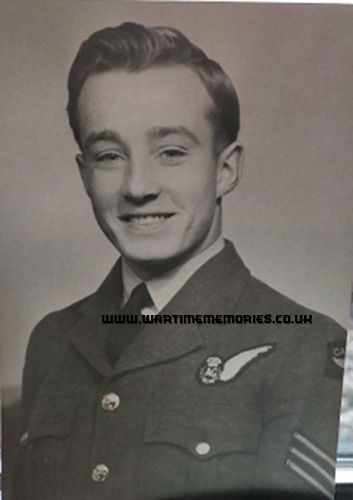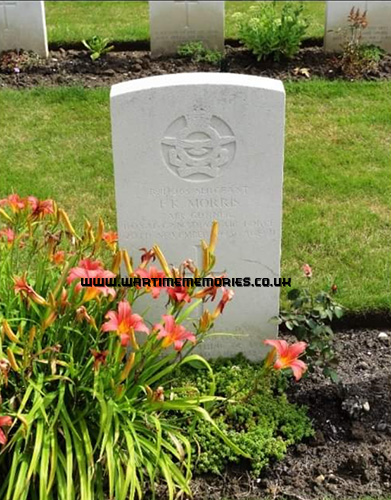Sgt. Francis Kempton Morris
Royal Canadian Air Force No. 429 Squadron
from:Sheenboro, Quebec
(d.20th Nov 1943)
Page 196 of the 1943 Book of Remembrance, also letters tell the story of Sheenboro airman’s death, by Jonathan Crowe:
Francis Kempton Morris's family first heard the news by telegram. Kemp, a native of Sheenboro, was a gunnery sergeant in the Royal Canadian Air Force. On the night of 18th of November 1943, his plane went on a bombing raid over Mannheim, Germany. The plane never returned. He had just turned 21 years old on the 15th. “They sent word, we got a telegram at the end of November that he was presumed missing,” says Grace Bryson, Kemp's younger sister. She remembers feeling “just shock” when her family heard the news. “We never thought that this would happen,” she said.
Kemp and Grace were the sixth and fifth youngest, respectively, of a family of 16 children. They were 18 months apart in age. “We always had a party,” says Grace, “because there were so many of us. We were an Irish-Catholic family.” Grace, now 79, lives in Pembroke, where she quilts for her grandchildren and for church missions. She remembers going to school in Sheenboro with her brother. “They used to think we were twins, even though there were 18 months between us,” she says.
Like his older brother, Melvin, who joined the navy, Kemp enlisted, joining the RCAF in high school in 1941. Two other brothers tried to sign up, but were turned down for health reasons. He went overseas in June 1943 and became an air gunner, his last mission was his 11th. “We just thought that, nine more flights and he’d be home,” says Grace. The family waited for word about what had happened to Kemp. Then, in January, they received word that his plane had been shot down and that he had been killed. Subsequent letters to the family revealed more and more details about what had happened to Kemp after he had been shot down. Another letter from the casualties officer said that, based on Red Cross information, when Kemp had been captured, he was taken to Ebernach, Germany. He had died at 9:45 p.m. on 20th of November 1943, “with a Catholic priest at his bedside.” The letter also enclosed a short, handwritten note from Kemp that he had written before going into surgery. But not all the letters came from the casualties officer's desk.
The first remarkable letter came from Father Walter Hauth. He was an assistant priest in Cochem, Germany, and was one of two priests who had administered Kemp's last rites. He wrote, in English, to Kemp's father on 17th of September 1946. “Your dear son smiled when the priest came in,” he wrote. “We had a nice little conversation. I can’t tell you how he was pleased when I heard his confession and gave him the blessing.” Three days after Kemp died, he gave the funeral mass. “Oh, I know I can't give you a word of consolation, I can't give you your dear son again, but I can tell you that he died in peace of God.”
Two letters, apparently unrelated, followed from Bruno Bous, an ambulance driver who received a call to pick up a young, wounded Canadian airman. Bous's letter added another piece to the puzzle of what had happened to Kemp. He wrote that he picked Kemp up from a doctor's private infirmary and transported him to the hospital in Cochem. Bous also was able to provide some information about where Kemp had been buried. “Mr. Morris was buried with full military honours in the cemetery of my native city Cochem. His grave is cared for and there is a cross and flowers. It bears the number 224. If you wish, I will send you a snapshot of the grave, and also of the monastery and the hospital where Mr. Morris died. Please let me know.” Finally, Bous wrote that he had found a blue cap that belonged to Kemp, and offered to send it to the Morrises. Bous wrote again in January 1948, after the Morrises had replied asking for more information. He promised to find out as much as he could. He contacted the hospital director and said that he would find the surgeons who had operated on Kemp.
Bous's efforts bore fruit when, on 13th of Feb. 1948, Dr. Peter Durr, one of the surgeons who had operated on Kemp, wrote a four-page letter describing the night Kemp's plane had been shot down and how he had died. Durr provided the Morrises with the most information yet about their son. He described the night of the bombing raid, and may have been a witness to Kemp's plane being shot down. He also included, to the best of his memory, Kemp's own account to him of being shot down. Because Durr could speak English, he assisted the hospital's chief surgeon in treating Kemp's injuries. “At last we came to the agreement that the only help that could be given to your son would be an operation, in order to see which of the internal parts were injured. Unfortunately, he had been wounded 12 hours earlier. There was less hope to save his life, in case the intestines should be wounded.” In the event, Kemp had been too badly injured to be saved. Nothing more could be done for him. “In case he had been turned in right after the accident it had been possible to save him,” wrote Durr. “But now it was too late. His injury resulted in an inflammation of the peritoneum. The process of the inflammation could not be stopped anymore.” “Everybody of us did his best to help him,” Durr added.
Priest, ambulance driver, doctor all were able, even willing, to tell the Morrises what they knew about their son. Even though Kemp had been on the other side and even though he had been involved in a bombing raid above their homes the night before. Grace remembers the letters well. “They were very touching,” she says.
Indeed, the family was moved enough to send care packages to Germany, sent, she says, to the man looking after her brother's grave. A number of private relief efforts were started after the war to send packages to Germany, official efforts were focused on non-German survivors, says Angelika Sauer, a history professor at Texas Lutheran University who specializes in postwar Canadian-German relations. “They organized clothing drives and collections,” says Sauer. “I seem to remember that they used the CARE program extensively because it was the easiest way to distribute relief in Germany.” Not only that, but the family sponsored, through a church-sponsored farm placement arrangement, a young German man to come to their farm to work for a year.
As for Kemp, his body was moved to a British Military Cemetery at Rheinberg, Germany. The RCAF casualties officer confirmed the exact location of his grave in a letter dated 12th Jan. 1949. In July 2002, Grace and her daughter took time out from an organized group trip to Ireland to visit Kemp's gravesite in Rheinberg. There were flowers at every gravesite, says Grace. “You couldn’t help but cry when you got there,” she says.
First published in The Equity, 5th Nov. 2003.

